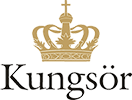History
The area that is now home to the municipality of Kungsör was inhabited as early as three - four thousand years ago. Its proximity to Lake Mälaren had a huge effect on everyday life here and the inhabitants appeared to have been relatively well off.
At the end of the Viking Age, a large piece of land between the Arbogaån and
Hedströmmen rivers was completely under water, but as the water level gradually subsided, excellent grazing lands emerged and the land that had previously been islands was built on. The chief judge Gregers Magnusson acquired a large estate with Grönö as its centre. This was later confiscated by the Crown and Gustav Vasa used it to set up a stud farm. In 1538 Gustav Vasa exchanged Grönö Manor and the five farms that he had acquired for Kungsör’s Royal Manor and a large number of nearby farms. This was how Kungsör was founded.
Gustav Vasa
At that time, Gustav Vasa’s estate consisted of 38 farms, 7 crofter’s holdings and several outlying tracts of land. He had Kungsör’s Manor renovated and carried out extensive work to increase the amount of arable land. Gustav Vasa was extremely interested in the farm and often came to Kungsör with his family and court. On such occasions there could be up to 250 people, calling for a considerable amount of food and drink.
In 1556, Gustav Vasa started to call the manor Ulvesund, but he paid his last visit there in 1560. On May 7, a fevered king arrived in Kungsör from Julita but died in September that same year from his illness.
Johan III
Of Gustav Vasa’s sons, it was Johan III that was most interested in spending time in Kungsör. In 1580 he started to build a castle on the Jägaråsen ridge, north of the manor, but work ceased after the foundations had been built. These foundations can still be seen at Rundelborg.
Queen Kristina
In 1639, the plague was rampant in Stockholm. Queen Kristina, who was thirteen years old at the time, sought refuge in Kungsör and stayed at the Royal Manor together with her mother for five months. Queen Kristina is closely associated with Kungsör and she rode at the labyrinth Rundelborg, which is still, called ”Queen Kristina’s riding track. The bridle path in Kungsör is also named after her.
Queen Kristina paid her last visit to the manor in 1652.
Karl XI
The Royal Manor’s heyday was under Karl XI’s reign. He visited Kungsör for the first time in 1672 and became a frequent visitor. Kungsör became his favourite place where he could escape the ostentatiousness of Stockholm and instead spend time hunting and fishing. The forests surrounding the manor were ideal for hunting bears, moose and wolves. The king became famous for his long and fast rides to and from Kungsör and was given the nickname ”Gråkappan” (Grey
Cloak. In January 1686, the king arrived in Kungsör after a 240-km ride from Eksjö that took just 20.5 hours. During the winter, the journeys to and from Stockholm, taking 5 – 6 hours, were by horse-drawn sleigh over a frozen Lake Mälaren.
The only permanent memorial we now have of Karl XI is the church, Kung Karls
kyrka, that he commissioned and paid for. His son, Karl XII, visited Kungsör many times when he was crown prince and was famous for hunting bear. He had no significant impact on the Royal Manor as he paid his last visit here when he was
just 17.
Fire at the Royal Manor
In the 18th century, the Royal Manor was visited less frequently by royalty.
Kungsör’s new importance as a shipping place for goods on their way to Stockholm also meant the end for the Royal Manor. In 1822, a spark from a boat landed on one of the thatched roofs and almost all of the Royal Manor’s buildings burned down.
Today’s Royal Manor
All that remains are parts of the Ladies in Waiting building that have been moved to the foundations of the old Royal Manor. This has now become Kungsör’s local museum and goes by the name Kungsudden.
Sources include David Norrhammar, Oskar Björnänger and Bengt Sörberg.
Kontakt för den här sidan:
Senast uppdaterad:

 Lyssna
Lyssna